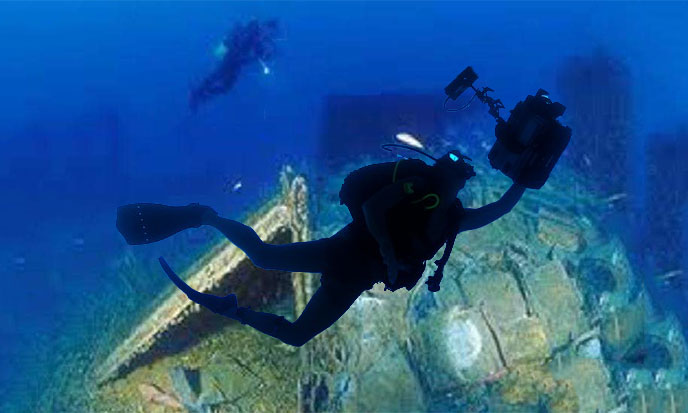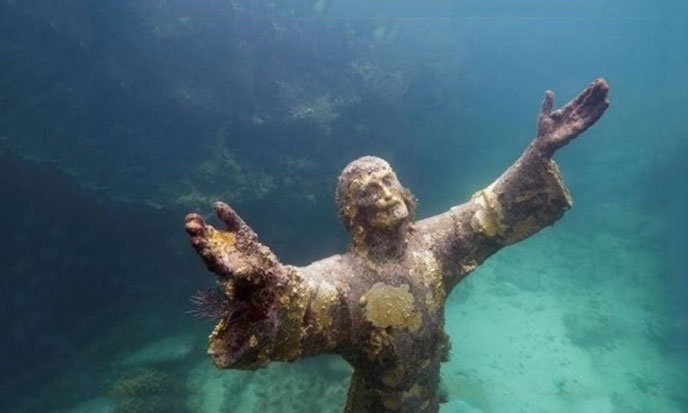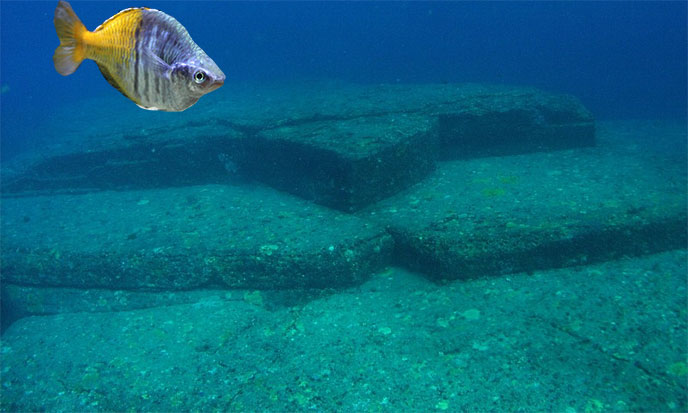![By Future map of the world (Own work) [CC BY-SA 3.0 (http://creativecommons.org/licenses/by-sa/3.0)], via Wikimedia Commons cites-englouties-sunken-city-688po](https://eden-saga.com/wp-content/uploads/cites-englouties-sunken-city-688po.jpg)
For ages, civilizations have developed along the coast. Our earliest ancestors, no doubt, were sailors. The famous Atlantis itself was a maritime empire, submerged by the rising waters at the end of last ice age.
Ten or twelve thousand years ago, indeed, sea levels began to rise rapidly: 130 meters within a few millennia. Of course, this increase was not regular. In many locations, the rupture of natural dams caused local floods that marked people’s memories and can be found in the local legends. We can do nothing against the rising waters. When the levees are not enough to stem the tide, we must abandon the land to the ocean.
Over the centuries,those of the sea had repeatedly renounced their ancestral land swallowed by the seasalt. The trauma was terribl eand lasting. Yet back several thousand years,the memory of this inexorable rise in the water still finds echoes in many legends of our Atlantic coast, which show the presence of ancient sunken cities.“Quantities of coastal towns were submerged recently, as the city of Ys in the Gulf of MorbihanThe author confuses Ys off Douarnenez in Brittany with another sunken city in the Gulf of Morbihan … But does it really matter? There are plenty of sunken cities or that of Tartessos at the mouth of the Guadalquivir.
We can add the famous and opulent city of Dorestad in Holland, which disappeared beneath the waves in the year 864 AD, or Vineta on the Baltic,which was founded in 950 and submerged by a tidal wave in the year 1100.We may also mention the archaeological site of Halieis, a small port in the Peloponnese, off which were found within ten meters of water an ancient Greek city dating from 5600 years,at a time when there was yet no Greeks but the Cretans or Mycenaeans.”(source)Maurice Chatelain, Our Cosmic Ancestors, 1978
In Britanny, there are numerous sunken cities and you can find countless stories and traditional songs. Each coastal region has its memories of loved ones, at the dawn of the world, in distant lands that are now deep in their bay. The Morbihan people remember the first Gwened, White City, now at the bottom the Gulf.
Those of Finistere remember the city of Ys off Douarnenez, in the wild Baie des Trépassés.bay of the Departed. Decorated with a truncated pyramid,the city of Ys was the second capital of the Tuatha. It lies beneath the Iroise a few cables’ length away from Ushant.

The people of Côtes d’Armor remember Nazado, a sunken city off Erquy, which was then only a tiny hamlet, destined to be a few millennia later the Roman port of Reginea – ancient name of Erquy. Around 6000 BP Nazado was a powerful Neolithic city built around a large white pyramid. It was located on the south shore of the estuary of a huge river about twenty miles north of Guernsey. This giant river found its final bed around 8000 BP, during the large thaw of Würm, and this bed is the current Channel.
Before the rising waters, the great river had major tributaries like the Seine, the Thames, the Rhine, the Somme and the Solent. It flowed into the Atlantic Ocean between Ireland and Brest. Near its mouth, at the southern tip of England were a few headlands, the Celtic Cassirétides islands, today drowned off the Isles of Scilly.
The White City
Somewhere in the inlet that separates France from England was formerly the prodigious magical city of the Hyperboreans, whose limestone glistened in the sun so bright that you could see its light from miles around on the sea.
This radiance and splendor earned it the name White City.
On a map of the English Channel in 9000 BP, we can see the large number of islands and islets that allowed easy passage of Britain in England. Some of these islands exploiting mineral or mineral resources. They were swallowed one after the other by the rising waters which lasted until 4000 BP.
One of these islands might have been the famous White City which the Celts have spoken of, but it was already legendary in their time. My research led me to the islands Cassirétides Celts, today drowned off the Isles of Scilly.
This sector has also experienced serious upheaval. “The Cassirétides islands, which provided in tin most of the bronze foundries along the Mediterranean, collapsed into the sea there are at least five thousand years, and the tip of Cornwall, where once stood the town of Dunwich, has slowly sunk beneath the waters for thousands of years. In this region, fishermen often find human or animal bones, broken homes and even whole trees. According to ancient writers Pliny and Ptolemy, other Cassirétides islands once stood at a hundred kilometers off the northwest tip of the Iberian Peninsula, which is also not unlikely because we found several sea mounts in the industry.” (source)Maurice Chatelain, Our Cosmic Ancestors, 1978
The term of sea mount means a submarine mountain, possible remnant of an old island. Be aware that many sea mounts scatter over the north Atlantic area, which can evoke remnants of ancient Atlantean islands…
These islands were not mainland Atlantis, because Atlantis was an artefact island, a mother spaceship which had once taken off from the ocean causing the great tsunami of the flood.
But all around this gigantic spaceship, many islands were commercial spots where people keep exchanging goods with healthy and magical Atlantis.
There is no way to find mainland Atlantis, for it’s gone. But we could look for the satellite islands and ports.

“According to Strabo, there were two islands called Hera and Gadir about one hundred kilometers west of the Strait of Gibraltar. They have also disappeared, but there are still some sea mounts there. Tartessos famous port at the mouth of the Guadalquivir in Spain, has also disappeared, which is not surprising when one remembers the Lisbon earthquake in 1775 that destroyed the city completely making more than fifty thousand victims, and took away the port in a bottomless abyss. It may be that the ruins of Tartessos are now more than 100 kilometers off the edge of the continental shelf of Spain.
It is now believed that all the islands described in ancient texts, and hitherto regarded as imaginary, actually existed in the recent past before sinking slowly into the waves.
And it is precisely these islands that could provide us the most ancient information about our distant ancestors, cosmic or not, and about the origins of our civilization.” (source)Maurice Chatelain, Our Cosmic Ancestors, 1978
As if on purpose, all the archaeological evidence are drown. And not just here! On the five continents, the sunken cities reflect the rising waters, a phenomenon that so many traditions call the Flood. Thus, the underwater pyramid Yonaguni, in Japan, may belong to the engulfed Empire of MU, like the sunken cities of India could be relics of the ancient empire of Rama. The underwater archeology has achieved in recent decades dramatic advances and dramatic results, although some scholars question them.
Soon the obvious will prevail even to historians.

The accumulation of ruins, growing older, more and more beautiful, will consolidate a more accurate view of our origins.
We come from far away. Long ago. And those who came before us knew much more than we do. We have forgotten them and will be forgotten as well.


